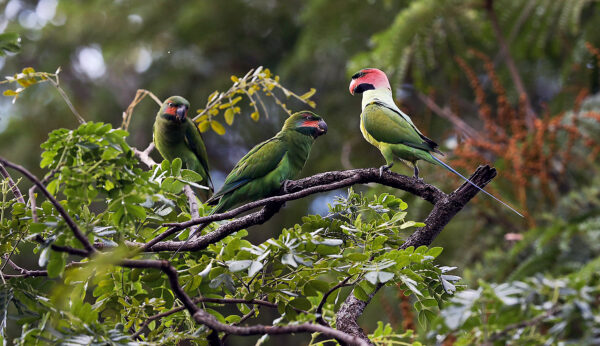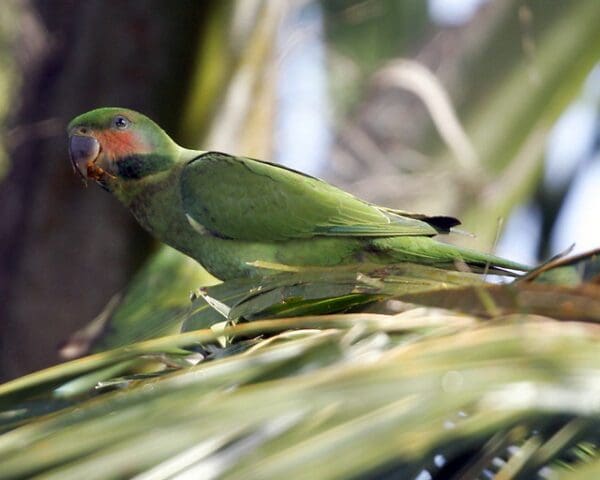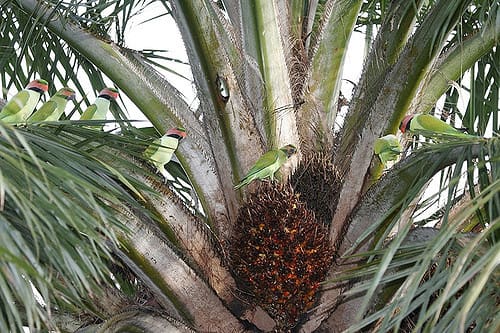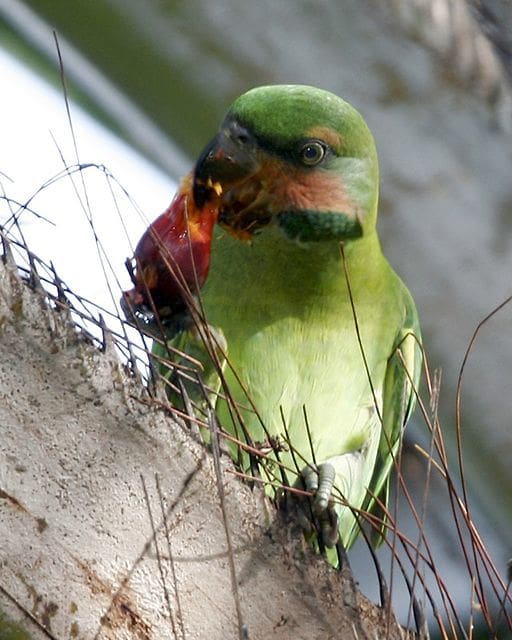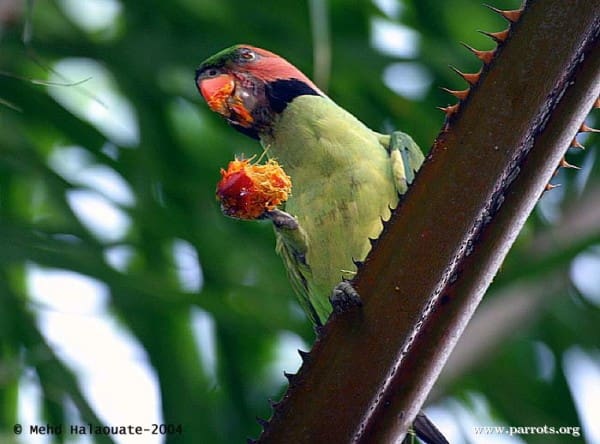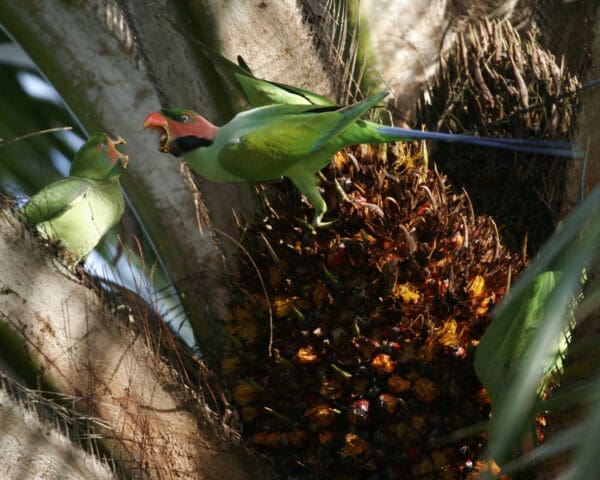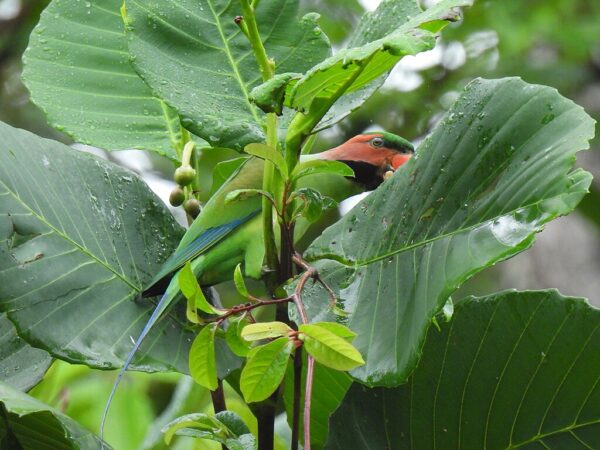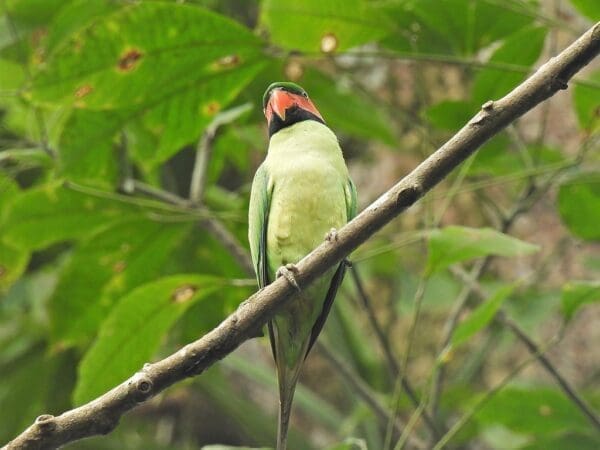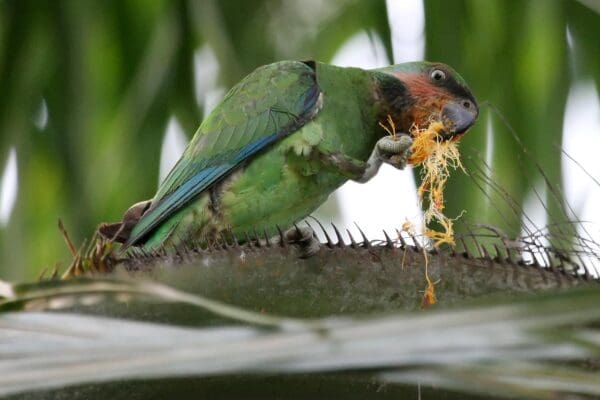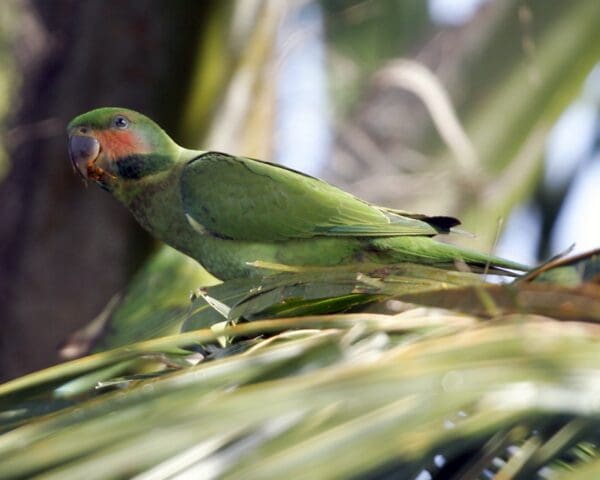Long-tailed Parakeet
Also known as:
Red-cheeked Parakeet, Malayan Long-tailed or Red-cheeked Parakeet (B.l. longicauda), Andaman Long-tailed or Red-cheeked Parakeet (B.l. tytleri), Nicobar Long-tailed or Red-cheeked Parakeet (B.l. nicobarica)
Also known as:
Red-cheeked Parakeet, Malayan Long-tailed or Red-cheeked Parakeet (B.l. longicauda), Andaman Long-tailed or Red-cheeked Parakeet (B.l. tytleri), Nicobar Long-tailed or Red-cheeked Parakeet (B.l. nicobarica)
![© lonelyshrimp [Public Domain] via Flickr Wild Long-tailed Parakeets perch in a tree](https://parrots.org/wp-content/uploads/1990/06/Long-tailed-Parakeet-lonelyshrimp-e1732057349481-100x100.jpg)
![© Lip Kee Yap [CC BY-SA 2.0] via Flickr A wild Long-tailed Parakeet feeds on fruits](https://parrots.org/wp-content/uploads/2023/01/wpt_Long-tailed-Parakeet_1289-7-100x100.jpg)
![© Lip Kee [CC BY-SA 2.0] via Flickr Wild Long-tailed Parakeets feed on palm fruits](https://parrots.org/wp-content/uploads/2023/01/wpt_Long-tailed-Parakeet_1289-6-100x100.jpg)
![© Lip Kee Yap [CC BY-SA 2.0] via Wikimedia Commons A wild Long-tailed Parakeet feeds on fruit](https://parrots.org/wp-content/uploads/2023/01/wpt_Long-tailed-Parakeet_1289-3-100x100.jpg)
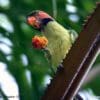
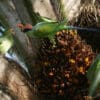
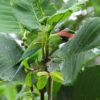
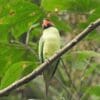
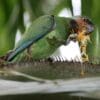
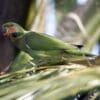
DID YOU KNOW?
The movements of the Long-tailed Parakeet are unpredictable; local numbers fluctuate widely between large noisy flocks and a complete absence of birds in any given area.

Belocercus

longicaudus
Size:
42 cm (16.4 in)
Weight:
125 g (4.4 oz)
Subspecies including nominate:
five: B.l. longicauda, B.l. defontainei, B.l. modesta, B.l. tytleri, B.l. nicobarica
Colour Adult:
B.l. longicauda: Male-blue/black lores and line through eye; rose/red sides of head and area behind eye to nape and hindneck; black chin and lower cheeks; dull yellow mantle and upper back washed with blue/grey; pale blue rump and lower back; dark blue, long, central tail feathers tipped yellow/green. Red upper mandible, dark brown lower mandible. Eye pale yellow. Female-dull orange/red upper cheeks, ear coverts and superciliary line to sides of occiput; dark green chin and lower cheeks; green nape and hindneck, reaching forward as thin band to eye; green mantle to upper tail coverts; short central tail feathers. Beak dark brown.
B.l. defontainei: Both adults as in longicauda, but crown more yellow; deep red upper cheeks.
B.l. modesta: Male-deep crimson sides of head, becoming paler on nape and hindneck; dull red crown tinted with green. Larger in size. Female-green/brown crown; red ear coverts with blue band bordering. Larger in size.
B.l. tytleri: Male-yellow/green nape to mantle and upper back and washed with grey/lilac; breast darker green and suffused with grey/lilac; green rump and lower back; centre tail feathers paler green/blue tipped with yellow/green. Larger in size. Female-bright green crown; red/pink upper cheeks and ear coverts; red/pink superciliary line absent; centre tail feathers shorter and paler green/blue tipped with yellow/green. Larger in size.
B.l. nicobarica: Male-bright green crown; yellow/green nape tinted with mauve; bright red ear coverts and upper cheeks; green upperparts, washed with blue on mantle. Larger in size. Female-olive/green crown and nape to mantle; brighter red ear coverts and upper cheeks but superciliary line absent. Larger in size.
Colour Juvenile:
B.l. longicauda: As in adult female, but with dull green upper cheeks and ear coverts washed with orange/red; superciliary line absent; in male, rump slightly suffused with blue. Tail short. Eye grey.
B.l. tytleri: As in adult female but with green sides of head washed with dull pink; green rump in both sexes. Eye grey.
B.l nicobarica: As in adult female, but sides of head green washed with dull red; green rump in both sexes. Eye grey.
Call:
Calls made in flight are described as loud and discordant, also high-pitched and melodious notes, nasal, quavering, goose-like sounds and bursts of scolding.
More Information:
Content Sources:
CITES
BirdLife International
Cornell Lab of Ornithology/Birds of the World
Parrots: A Guide to Parrots of the World, Juniper and Parr, 1998
Parrots of the World, Forshaw and Cooper, 1977. 2010 edition
Lexicon of Parrots, Thomas Arndt.
Parrots of the World, Forshaw, 2006.
Parrots in Aviculture, Low, 1992.
Captive Status:
Rare; mortality is high in wild-caught birds and breeding successes are rare.
Longevity:
—
Housing:
Walk-in enclosure, minimum length 3 m (9.8 ft).
Diet:
Fruit such as: apple, pear, bananas, orange, cactus fruits, pomegranate, forming about 30 percent of diet; fresh papaya seeds; vegetables such as: carrot, celery, green beans and peas in the pod; fresh corn; green leaves such as: Swiss chard, lettuce, sowthistle, dandelion, chickweed; spray millet; small seed mix such as: canary, millet and smaller amounts of oats, buckwheat, safflower and a little hemp; soaked and sprouted sunflower seed; cooked beans and pulses, boiled maize; complete kibble.
Enrichment:
Not an avid bather, but will bathe occasionally under overhead misters or if out in warm rain. Enjoys chewing, so provide bird-safe, unsprayed fir, pine, willow and flowering branches, wooden toys, heat sterilized pine cones and vegetable tanned leather toys.
Nest Box Size:
Vertical box 9″ x 9″ x 24″ (22.8 cm x 22.8 cm x 61 cm).
Clutch Size:
2-4
Fledging Age:
7 weeks
Hatch Weight:
—
Peak Weight:
—
Weaning Weight:
—
World Population:
Unknown but described as fairly common, decreasing.
IUCN Red List Status:
Vulnerable
CITES Listing:
Appendix II
Threat Summary:
Rates of forest loss in the Sundaic lowlands have been extremely rapid due to the escalation of logging and land conversion. Still occurs in large numbers in some areas of Brunei and common in Andaman and Nicobar Islands. The species is estimated to have lost almost one-third (32·4%) of its habitat within its distribution over three generations (24 years).
Range:
B.l. longicauda: Malay Peninsula, south from Kedah and Anambas Islands, and on Singapore. Also offshore islets, Borneo, and Sumatra, including Nias and Bangka Islands.
B.l. defontainei: Natuna Islands, Riau Archipelago, Bintan, Karimata, and Belitung Islands, Indonesia.
B.l. modesta: Enggano Island, off SE coast of Sumatra, Indonesia.
B.l. tytleri: Coco and Andaman Islands, in Bay of Bengal.
B.l. nicobarica: Nicobar Islands, in Bay of Bengal.
Habitat:
Found up to 300 m (984 ft) in various types of habitat, mainly lowland evergreen forest from mangroves, swamp forest, rainforest, oil palm plantations and coconut groves. Also frequents parks and gardens, as well as cultivated areas.
Wild Diet:
Feeds on outer covering of betel nuts Areca catechu, papaya Carica papaya, ripe Pandanus fruit, fruits of kapor Dryobalanops, Dillenia speciosa and Sonneratia alba, flowers of Acacia and Bombax, seeds of Macaranga, Ixonanthes, Vitex pybescens, Lagerstroemia, Dipterocarpus crinitus and Dillenia fruit, papaya, betel nuts, orchard and plantation fruit, grain and seeds.
Ecology and Behaviour:
Social; flocks of thousands of birds reported from Andamans and Borneo. Smaller groups more usually seen, particularly during the breeding season. Colony breeder.
Clutch and Egg Size:
2-4 rounded eggs, 30.5 x 24.5 mm (1.2 x 9.5 in).
Breeding Season:
December-July, Malay Peninsula; February-April on Nicobar Islands and Andamans. Nest is in tree cavity.
Related Links:
